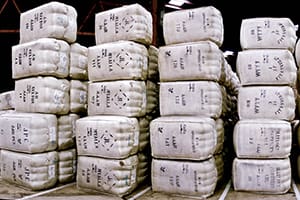 AUSTRALIAN wool auction prices fell further this week, despite the latest bale testing figures highlighting the recent drop in greasy fibre production due to the drought and seasonal conditions.
AUSTRALIAN wool auction prices fell further this week, despite the latest bale testing figures highlighting the recent drop in greasy fibre production due to the drought and seasonal conditions.
The AWEX Eastern Market Indicator closed at 1992c/kg clean this week, after losing 21 cents in the third consecutive week of losses, which now total 102 cents.
The Australian Wool testing Authority’s latest figures show that for the month of September 19.2 percent less greasy wool was tested compared to the same period last year.
Brokers passed in 10.9pc of the 39,261 bales offered, which was 6276 fewer than presented the previous week.
AWEX senior market analyst Lionel Plunkett said the superfine types that were hardest hit.
“The finer the wool the greater the losses; 16.5 micron and finer were 90 to 100 cents easier, and 17 to 18 micron were generally 40 to 80 cents cheaper.”
He said there was strong demand for the 19.5 to 21.5 micron wools, resulting in these types recording gains of 5 to 15 cents for the week.
Mr Plunkett said it is difficult to attribute this week’s losses to currency movements, highlighted by the fact, that when viewed in $US terms, the EMI over the same period has fallen by US93c/kg.
“Despite the EMI recording overall losses for the week, there were positive signs apparent later in the series.
“The northern and southern indicators were basically unchanged on the second selling day,” he said.
“Fremantle, which finished off the selling for the week, recorded overall positive movement on the last day, pushing the western indicator up a healthy 17 cents.”
Mr Plunkett said the skirting sector had a week of mixed results.
“Wool carrying less than 2pc vegetable matter (vm) attracted spirited bidding, resulting in gains for the week of 20 to 30 cents.
“As the amount of vm increased, buyer demand decreased, causing prices to generally fall by 20 to 40 cents, lots with more than 8pc vm most-affected.”
The oddments continued to record further losses, prices generally fell by 35 to 50 cents,” Mr Plunkett said.
Size of wool supply drop not anticipated
The Australian Wool Innovation weekly market report said “under a general cloud of weakness, many sectors actually managed to exhibit signs of improvement in demand as buyer confidence grew as prices lowered, particularly in $US terms.”
AWI said the latest AWTA data showed substantial declines in the volume of wool tested on a year-to-year comparison.
“Many of the local traders here had anticipated such a fall in supply, but the first two months data of this selling season went somewhat against their thinking by only reducing the clip volume by 5.7pc compared to last season.
“The September test figures though have revealed the true effect of the drought on wool production and substantially pushed out the season on season figure to an 11.4pc shortage compared to the same period of last year,” AWI said.
“To highlight what a precipice wool production is sitting on, the month of September in isolation presented 19.2pc less wool for testing by greasy raw weight than what was tested in the same month last year.
“These volume reduction figures are extremely significant in themselves, but additionally the drought is, and will further, impact the amount of clean kgs produced from Australia,” AWI said.
“The average dry yield has decreased nationally from 64.6pc to 63.1pc compared to last season at the same time, which is a further 2.3pc loss in clean weight produced against the lower volume.
“So far this season, micron is 0.5pc finer, greasy staple length is 3.3mm shorter and VM is 0.3pc lower, but surprising that the staple strength is stronger by 0.3 Newtons/kilotex,” AWI said
“So, in summary, the national clip from Australia when expressed in clean kgs is actually 13.52pc lower than at the same time last season or 45.811 million clean kgs against the 52.972 million clean kgs tested last season.
“This is a 7.161 million clean kg reduction in just three months,” AWI said.
Next week with just 34,467 bales being offered, prospects look good given the positive conclusion to the week, AWI said.
Sources: AWEX, AWI.



HAVE YOUR SAY